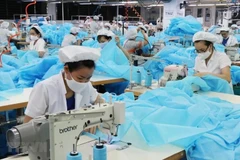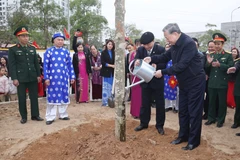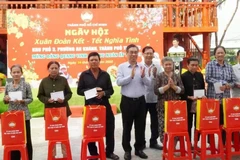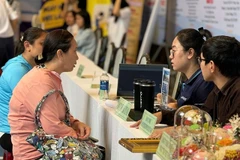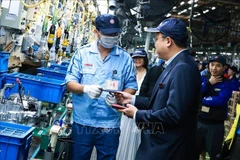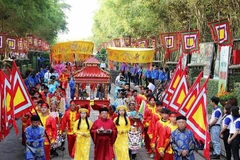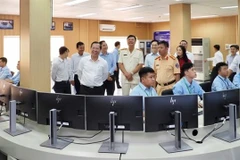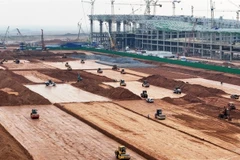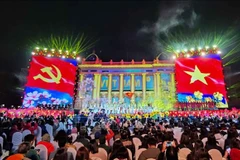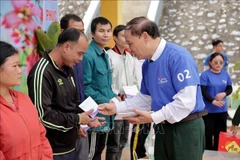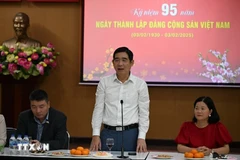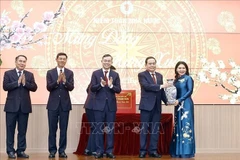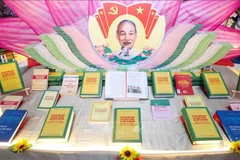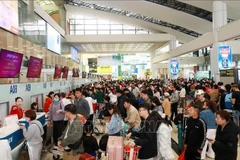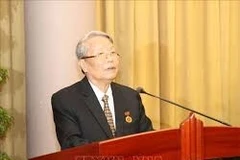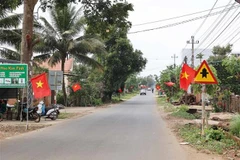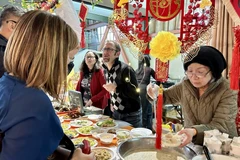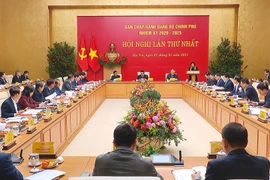The Vietnam National Museum of History held aseminar on December 30 for cultural researchers and archaeologists, whoreported the results of excavations in Thanh Khuong commune, Thuan Thanhdistrict, the northern province of Bac Ninh, and at Luy Lau Citadel.
Underan agreement to strengthen and promote academic exchange betweenVietnam and Japan, a team from the history museum and the University ofEast Asia in Japan has started excavating the Luy Lau archaeologicalsite in a project lasting until 2019. The university's Professor HuangXiaofen led the team.
Museum officer Truong Dac Chien, one amongexcavators, presented pieces of bronze drum moulds and traces of drumcasting materials to the seminar's participants.
Dong Son drums(also called Heger Type I drums) are bronze instruments created duringthe time of Dong Son, a developed Bronze Age culture that lived innorthern Vietnam. The drums symbolise the culture and exemplify finemetalworking.
According to Chien, the drums were both musicalinstruments and cultural objects. They were decorated with geometricpatterns, scenes from war and daily life, animals and boats.
"This is the first time we found a large amount of debris from the drum-casting process," Chien said.
"Theyare all in a stable geological layer dating from the 4th century. Nowwe can affirm the time period during which Dong Son drums were made andthe casting method. We determined that the drums belong to the nativeculture."
Before, archaeologists believed that ancient peopleused wax or pottery to make moulds for casting drums. They supposed thatwhen the process was complete, the mould would be broken and the waxmelted down. That's why it's hard to find traces of the bronze drumcasting process.
"The missing knowledge of how, when and where bronze drums were made left a gap in scientific research," Chien said.
"Scientists have wondered whether Dong Son drums were made at the site or brought from other regions."
Bronzedrum casting started with shaping a clay mould on a turning table. Thenthe caster would cover the mould with another layer of clay, leaving aspace between the two layers to pour melting bronze inside. The casterwould carve designs into the two pottery layers and the drum's face.
The turning table created a centrifugal force to let bronze spread evenly throughout the mould.
Chiensaid the archaeologists found pieces of the pottery moulds withpatterns on them, a funnel for pouring liquid bronze and a bolt from theturning table's axle.
Prof Huang called Luy Lau Citadel an important relic in the region.
"Luy Lau was a political and cultural centre for the country 2,000 years ago," Huang said.
"It'srare to see a vestige of an ancient urban area with administrativefunctions, a military base, a residential area and bronze-castingworkshop. It's also uncommon to see an urban area so close to agraveyard. The two sites have a close relationship that requiresscientists to excavate and research both to be able to see the Citadeland all its history clearly."
Apart from bronze drum casting leftovers, scientists also found evidence of the outer and inner layers of the citadel.
Inthe near future, the archaeologists will expand their excavation to tryto find traces of a harbour on the Dau River that was first spotted insatellite photos.
"The group of Japanese experts specialise indifferent fields such as archaeology, geology, cultural research andremote sensing," said Chien.
"Thanks to the partnership with them, we can carry out professional research and gain a panoramic view of the relic."-VNA
